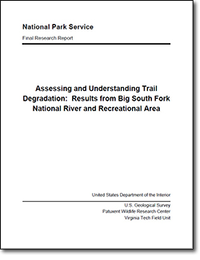Assessing and Understanding Trail Degradation: Results from Big South Fork National River and Recreational Area
Links
- More information: Publisher Index Page (via DOI)
- Document: Report (2.23 MB pdf)
- Download citation as: RIS | Dublin Core
Abstract
Suggested Citation
Marion, J., Olive, N., 2006, Assessing and Understanding Trail Degradation: Results from Big South Fork National River and Recreational Area, iv, 80 p., https://doi.org/10.3133/5200309.
| Publication type | Report |
|---|---|
| Publication Subtype | USGS Unnumbered Series |
| Title | Assessing and Understanding Trail Degradation: Results from Big South Fork National River and Recreational Area |
| Subseries | National Park Service, Final Research Report |
| DOI | 10.3133/5200309 |
| Year Published | 2006 |
| Language | English |
| Publisher | U.S. Geological Survey |
| Publisher location | Reston, VA |
| Contributing office(s) | Eastern Ecological Science Center |
| Description | iv, 80 p. |
| Public Comments | Original contributing office: Patuxent Wildlife Research Center |


